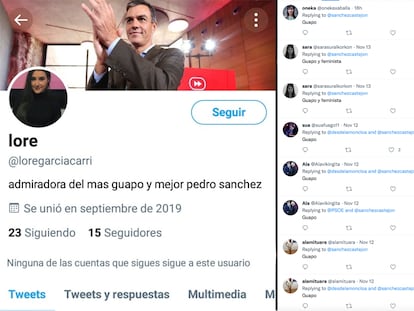Activism or ‘clicktivism’? Solidarity and posturing on social media
Online campaigns offer instant visibility but also let people forget the need for action in the real world, while some influencers use them for self-promotion

All social movements in existence today were born or are being amplified by the internet. Activists and their organizations have rushed to Twitter, Instagram, Facebook and LinkedIn with the aim of bringing about a particular change in the status quo, but online activism is a double-edged sword, where immediate success can mean defeat in the long run. Among grassroots activists out in the field, it can actually be a constant source of frustration.
On social media, where everyone’s voice is supposedly welcome, visibility and immediate connection are prioritized. “If I can’t dance I don’t want to be part of your revolution,” once said the feminist icon Emma Goldman, long before the internet was born. Today a young woman dances on Instagram to the Olivia Rodrigo lyrics: “Good for you, you’re doing great out there without me, baby, like a damn sociopath!” while calling out brands that do the bare minimum and call themselves sustainable. Short, punchy messages spark interest, are easy to understand and connect with the young. For Noelia García-Estévez, a sociologist specializing in digital activism, although liking or posting a particular photo is “low-involvement activism,” at least it brings an issue to the fore and sometimes manages to get it onto the public agenda.
Visual culture theorist Nicholas Mirzoeff, who spoke to this newspaper by phone from New York University, equates online protests to the overthrow of symbols of colonialism: “Toppling a statue is just a stepping stone, but it allows you to point out social inequalities,” he said. Sometimes, the speed of publishing is a matter of life and death. Amnesty International was born in 1967 when its founder called for people around the world to write letters to the Portuguese government [then under the autocratic leadership of Antonio Salazar] over the imprisonment of students. Its first digital campaign in 2002 helped prevent, with millions of online signatures, two women from being stoned to death in Nigeria. For Maribel Tellado, Amnesty Spain’s mobilization officer, “digital activism does not kill or replace the star of the street, but makes it shine brighter.”
But some consider the transience of social media posts and the low involvement of users as undermining systemic change. Sociologist Zeynep Tufekci, author of Twitter and Tear Gas, concluded in 2015 that activists today share a widespread frustration. Contemporary movements such as the Gezi Park sit-ins in Turkey, the Arab Spring and the protest movement in Hong Kong, in which the internet played a key role, have lost the benefits of careful long-term planning, according to the scholar. In the movement against racial segregation in the 1960s in the United States, activists gathered for years to write pamphlets that they then distributed across the country through dozens of organizations. “When you see the March on Washington in 1963, when you look at that picture, where this is the march where Martin Luther King gave his famous “I have a dream” speech, you don’t just see a march and you don’t just hear a powerful speech, you also see the painstaking, long-term work behind it… and if you’re in power, you realize you have to take the capacity signaled by that march, not just the march, but the capacity signaled by that march, seriously,” said Tufekci in a TED talk. “In contrast, when you look at Occupy’s [2011 protest movement] global marches that were organized in two weeks, you see a lot of discontent, but you don’t necessarily see teeth that can bite over the long term.”
When political engagement becomes a matter of clicks, the power of the internet as an engine of change becomes a mirage
After the murder of George Floyd at the hands of a police officer in Minneapolis in 2020, Instagram was filled with black squares in a viral campaign known as #BlackOutTuesday. The idea was to educate users about racism with recommendations of books, essays and documentaries, but these were lost among a sea of black square icons posted by people who wanted to show their solidarity with the movement. Members of the Black Lives Matter collective urged Instagram users to stop and a debate resurfaced about the extent to which people show solidarity on networks with situations they do not understand, in order to make themselves relevant in the eyes of their followers.
At a time when advertising speaks of the circular economy, feminism and LGBTQ+ rights, and activists are media stars in their own right, seeming politically engaged online is all the rage. In Trick Mirror: Reflections on Self-Delusion, the American journalist Jia Tolentino defines expressions of solidarity on the internet as a performative mode of listening: “It’s because of the hashtag, the retweet, and the profile that solidarity on the internet gets inextricably tangled up with visibility, identity, and self-promotion.” Meanwhile, strikes or boycotts continue to exist on the margins of society.
When political engagement becomes a matter of clicks, the power of the internet as an engine of change becomes a mirage, some warn. In 2010, Micah White, one of the founders of the anti-inequality movement Occupy Wall Street, wrote in The Guardian: “In promoting the illusion that surfing the web can change the world, clicktivism is to activism as McDonald’s is to a slow-cooked meal. It may look like food, but the life-giving nutrients are long gone.” Indian trans activist Zainab Patel says over the phone from New Delhi, India, that while social movements require the work of both online “opinionators” and activists on the ground, there is a huge disconnect between the conversations that take place in a virtual space and what happens in reality. The loudspeaker of social media is limited to those who have access to the internet and speak certain languages, and one of the main problems, according to Patel, is to identify the points of view that matter. In every group there are voices that shout louder than the rest, and on the internet the din of some commentators continually threatens to derail real dialogue.
Jordan Flaherty, a journalist and author of No More Heroes, points out that social media can only simulate, not replace, empathy: “Empathy can only come from looking someone in the eye and hearing their voice in person, and is something that any progressive or radical movement for change needs,” he emphasized.“Likes” make issues visible in a few seconds. But when actions are reduced to the virtual, they soon fade away. Solid, physical movements are needed to combat climate change, inequality and authoritarianism.
For sociologist García-Estévez, the root of the debate lies in the eternal dichotomy between immediate and lasting success: “We need to get to the second step of critical thinking to achieve greater changes.” Perhaps the answer to achieving a deeper, effective collective awareness to achieve systemic changes starts by simply going out onto the street and helping our neighbors.
Tu suscripción se está usando en otro dispositivo
¿Quieres añadir otro usuario a tu suscripción?
Si continúas leyendo en este dispositivo, no se podrá leer en el otro.
FlechaTu suscripción se está usando en otro dispositivo y solo puedes acceder a EL PAÍS desde un dispositivo a la vez.
Si quieres compartir tu cuenta, cambia tu suscripción a la modalidad Premium, así podrás añadir otro usuario. Cada uno accederá con su propia cuenta de email, lo que os permitirá personalizar vuestra experiencia en EL PAÍS.
¿Tienes una suscripción de empresa? Accede aquí para contratar más cuentas.
En el caso de no saber quién está usando tu cuenta, te recomendamos cambiar tu contraseña aquí.
Si decides continuar compartiendo tu cuenta, este mensaje se mostrará en tu dispositivo y en el de la otra persona que está usando tu cuenta de forma indefinida, afectando a tu experiencia de lectura. Puedes consultar aquí los términos y condiciones de la suscripción digital.
More information
Archived In
Últimas noticias
Most viewed
- Sinaloa Cartel war is taking its toll on Los Chapitos
- Oona Chaplin: ‘I told James Cameron that I was living in a treehouse and starting a permaculture project with a friend’
- Reinhard Genzel, Nobel laureate in physics: ‘One-minute videos will never give you the truth’
- Why the price of coffee has skyrocketed: from Brazilian plantations to specialty coffee houses
- Silver prices are going crazy: This is what’s fueling the rally










































